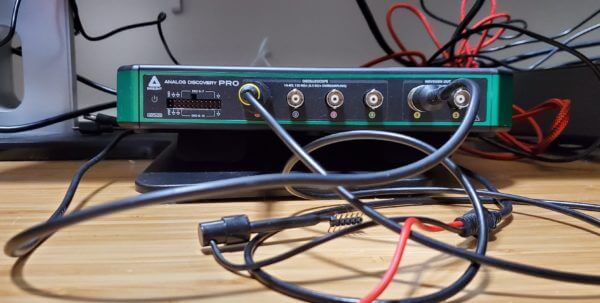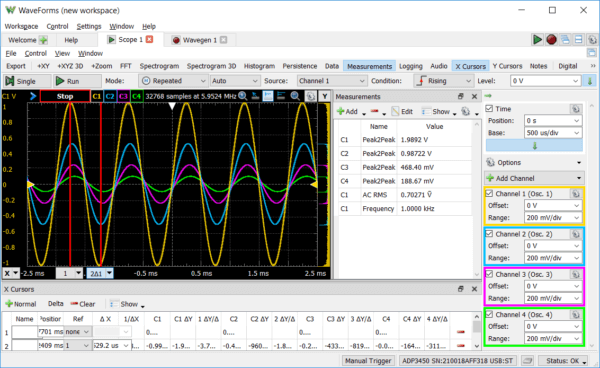It Starts with the Analog Discovery
Since our founding over two decades ago, Digilent has used expertise in low-cost FPGA tools from industry leader Xilinx, in combination with parts and peripherals of leading technology to provide accessible FPGA development platforms, bridging the gap between industry and individuals. Starting as an excellent showcase of FPGA technology, products like the Analog Discovery quickly took hold in academia and spread into industry by taking advantage of the flexibility of reprogrammable hardware to the test and measurement world.
By using FPGA technology at the core, the Analog Discovery can operate mixed signal and mixed domain analysis while providing a wide range of benchtop devices in a portable PC-connected device. Over the years of refining the software and adding new instruments as our industry wide customers needed them, the Analog Discovery quickly became a toolbox staple with its ability to apply to a broad range of applications and specifications targeted as such, or as I like to say, it’s “good enough for most things”.
We’ve Made the Analog Discovery Line Better
Being built on reprogrammable hardware connected to a PC we’ve been able to add an immense amount of functionality and flexibility to the device, and adapted the design into new tools such as the Digital Discovery, but as our world becomes increasingly more demanding on engineers and increasingly more remote, we took all of the feedback we received, and the examples from our customers incredible ingenuity (like chaining multiple Analog Discoveries together with the dedicated trigger channels) and have put them into our new products, the Analog Discovery Pro line.
To create the first in this new level of products we took the core feedback we’ve been receiving and put it into one device: more customizability, more oscilloscope channels, a faster sampling rate, larger buffer size, integrated BNCs, networking, and the addition of features typically found on benchtop oscilloscopes. The trick with creating this new product was keeping the core of what makes an Analog Discovery – mixed signal functionality, mixed domain analysis, an entire benchtop of instruments in one device, and the high-resolution ADCs and DACs.

What Makes an Analog Discovery Pro
Using our expertise in Zynq-based boards and designs, we took 14-bit 125 MS/s ADCs and DACs and created the first model of the Analog Discovery Pro line, the ADP3450. In this device, we took all that is beloved about the Analog Discovery and added oversampling to reach up to 0.5 GS/s sampling rate, four oscilloscope channels, benchtop scope features such as AD/DC coupling and hardware bandwidth filters, a MS buffer size, and a terminal-based Linux operating system. The ADP3450 features two unique modalities: ‘Linux Mode’ provides the option to write custom tests with advanced triggering, and ‘Standard Mode’ keeps the stability and ease of use of a USB instrument. Coming along with the upgrade to a Zynq-based device is a significant size increase in the FPGA itself, leaving the potential for upgrades only limited by imagination, and of course, the number of logic gates.

I’m looking forward to seeing all the amazing applications and customized test systems that our customers come up with using this new generation of devices (and of course, who can combine the most WaveForms devices to create the ultimate stacked test device).





Speaking about a stack of ADP3450 devices, how are the separate units synchronized to create an 8, 12, 16 … channel acquisition system? Do the combined stack of devices appear under one instantiation of WaveForms? Or does each unit have its own sample clock that will drift between the devices?
At the moment, the way to synchronize the devices is with the triggers and separate instantiations of WaveForms (People do it with the Analog Discovery 2 currently). It’s on the roadmap to do multiple devices in one WaveForms instance, but there’s no timeline on it just yet!
Digilent has been doing great. I like a circuit board with multiple SPST switches and LEDs and momentary buttons. Compared with a microcontroller, the modulation information is relatively easy to call out from the serial port or the LCD through a single C function call, and it is a bit difficult to debug the FPGA design. LED provides a zero-operation way to break through internal signals to achieve visualization-if you are tracking the progress of a complex state machine, you can light up the LED when the LED reaches a certain point without adding any additional logic.
Although these are easy to add by yourself, I find that it is best to find a circuit board with these components, so that you will not waste valuable I/O interfaces or waste time studying the faults caused by your soldering technology.
Digilent has introduced standard form factors for additional products, including a variety of Pmod and Papilio Wings.